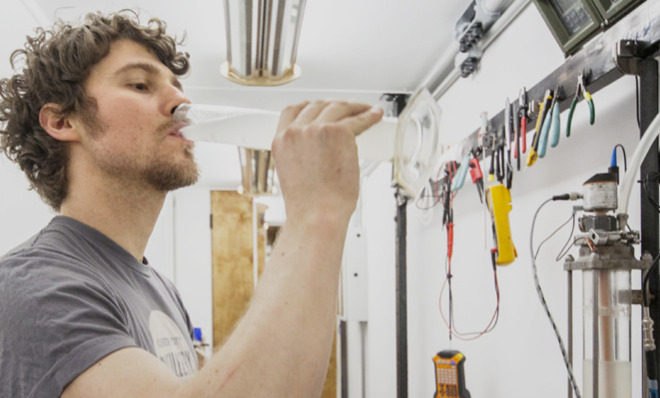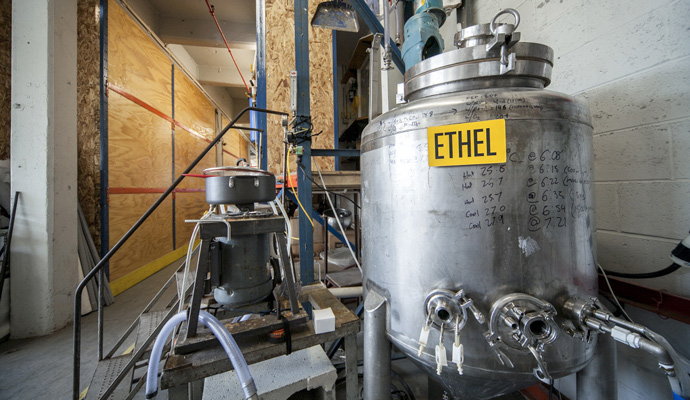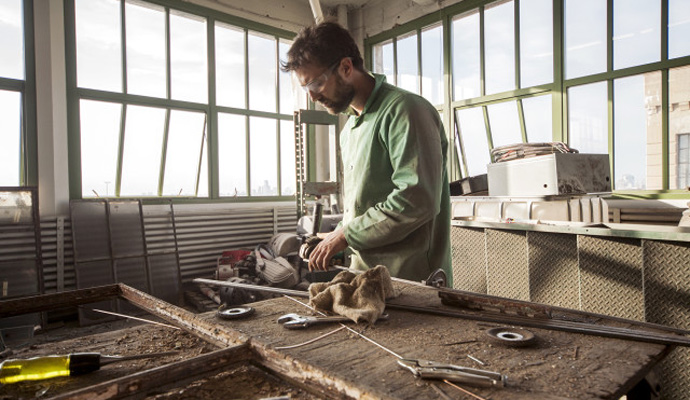The great Brooklyn vodka experiment
The five young men behind Industry City Distillery want to change our minds about vodka


Vodka, straight up. That's not an order you hear too often. In this country, at least, vodka is more often a cocktail ingredient than its own autonomous liquid. We appreciate its high proof, but mask the taste with sugary mixers like Red Bull or cranberry juice.
My freshman year in college, in an attempt to remove the flavor of rubbing alcohol, some friends ran a $5 liter of bottom shelf vodka through a Brita filter. The vodka rendered the Brita useless and stubbornly retained its eye-watering odor. The best vodkas on the market, we came to believe, must taste like nothing at all.
The five young men behind Industry City Distillery want to change our minds about vodka. The first project of the City Foundry, a small research and design group that its founders describe as "a research and design collective dedicated to rethinking small-scale manufacturing through science and art," the distillery is an attempt to create vodka one would gladly drink straight. At the same time, it's a way to jump-start the City Foundry, which occupies a 6,000-square-foot, sixth-floor warehouse space in Industry City, a now-quiet stretch of Sunset Park, Brooklyn, that was once one of New York's busiest shipping and manufacturing complexes. Vodka happens to be the first thing they wanted to make.
The Week
Escape your echo chamber. Get the facts behind the news, plus analysis from multiple perspectives.

Sign up for The Week's Free Newsletters
From our morning news briefing to a weekly Good News Newsletter, get the best of The Week delivered directly to your inbox.
From our morning news briefing to a weekly Good News Newsletter, get the best of The Week delivered directly to your inbox.
(More from Narratively: Tales from drinking in New York)

"We really like making vodka," says Peter Simon, one of the founders. "But distilling alcohol also turned out to be a great project to get our feet wet. It involves biology, machining, tons of research into physics and chemistry. It gave us a reason to build out our facilities and start producing and selling stuff right away."
Industry City Distillery is one of many micro-distilleries that have popped up in Brooklyn over the last few years. In 2007, then-governor Eliot Spitzer signed the Farm Distillery Law, which cut annual licensing fees for micro-distilleries in New York state from $50,000 to $15,000. The reduction was crucial for low-budget start-ups. Today, the so-called Brooklyn Spirits Trail features nearly a dozen small-batch distilleries, including Breuckelen Distilling, the Van Brunt Stillhouse and the Kings County Distillery. In contrast to corporate mega-brands like Jack Daniels and Absolut, these upstart spirit purveyors pay homage to the ancient art of distilling by producing their own craft versions of whiskey, rum, grappa, and even moonshine.
Like most of Brooklyn's craft distillers, the men behind ICD have no background in alcohol. Prior to launching the City Foundry in September 2011, their careers and interests were a study in post-graduate randomness. David Kyrejko, 28, built aquatic ecosystems; Rich Watts, 27, did graphic design; and Peter Simon, 25, was a barista and yoga teacher. Zac Bruner, 27, ran a machine shop in Providence, R.I., and Max Hames, 28, worked as a commercial fisherman in Alaska.
A free daily email with the biggest news stories of the day – and the best features from TheWeek.com
After Kyrejko brainstormed the initial idea for the City Foundry he brought on classmate Watts, who graduated with him from Cooper Union's art school in downtown Manhattan. They recruited Bruner, a longtime friend of Kyrejko's from summer camp, and Simon got into the mix after he served a coffee to Kyrejko one day. Hames joined the team through a friend of a friend. By the summer of 2011, they had all quit their respective jobs.
(More from Narratively: A eulogy for the ultimate dive bar)

What sets the men of ICD apart from the borough's other hip new booze makers is that distilling alcohol is only a short-term goal. Many microdistilleries start with vodka because it's cheaper and easier to make than whiskey, the ultimate American spirit. The low overhead of vodka production allows microdistillers to pay off the cost of their stills while becoming familiar with the distilling process. But the men of ICD say they don't want to make whiskey, even though they drink it. Instead, they want to make a superior ethanol, the chemical component of vodka. Once they've done that, they say, they can move on to other things that might not involve alcohol at all.
Their goal, in essence, was to make craft vodka that is profitable enough to finance new ventures. "It sounds cheeky," says Simon, "but we wanted booze to pay for the science and future research and development."
They cobbled together enough money for a few months' rent, and considered launching a Kickstarter campaign to fund the distillery. Kickstarter, however, does not allow its campaigns to offer alcohol as a reward. Instead, they hurled themselves into the project and committed to making anything they couldn't afford on-site.
(More from Narratively: The wonderbrewer of Nowheresville)
The space contains a mechanical shop, a laboratory, an office space with a print shop, a manufacturing center and a kitchen. Bottles of rum and gin blends line the kitchen's bright red shelves and serve as inspiration for the distillery's concoctions.
Simon, the business manager of the operation, explains that most vodka makers order alcohol in bulk and then blend it with their own additives, such as menthol or citric acid. This keeps prices low while making a vast amount of alcohol. But the ICD guys wanted to do more than splash some Brooklyn tap water into the mix and call it a craft product.
Read the rest of this story at Narratively.
Narratively is an online magazine devoted to original, in-depth and untold stories. Each week, Narratively explores a different theme and publishes just one story a day. It was one of TIME's 50 Best Websites of 2013.
-
 7 bars with comforting cocktails and great hospitality
7 bars with comforting cocktails and great hospitalitythe week recommends Winter is a fine time for going out and drinking up
-
 7 recipes that meet you wherever you are during winter
7 recipes that meet you wherever you are during winterthe week recommends Low-key January and decadent holiday eating are all accounted for
-
 Nine best TV shows of the year
Nine best TV shows of the yearThe Week Recommends From Adolescence to Amandaland